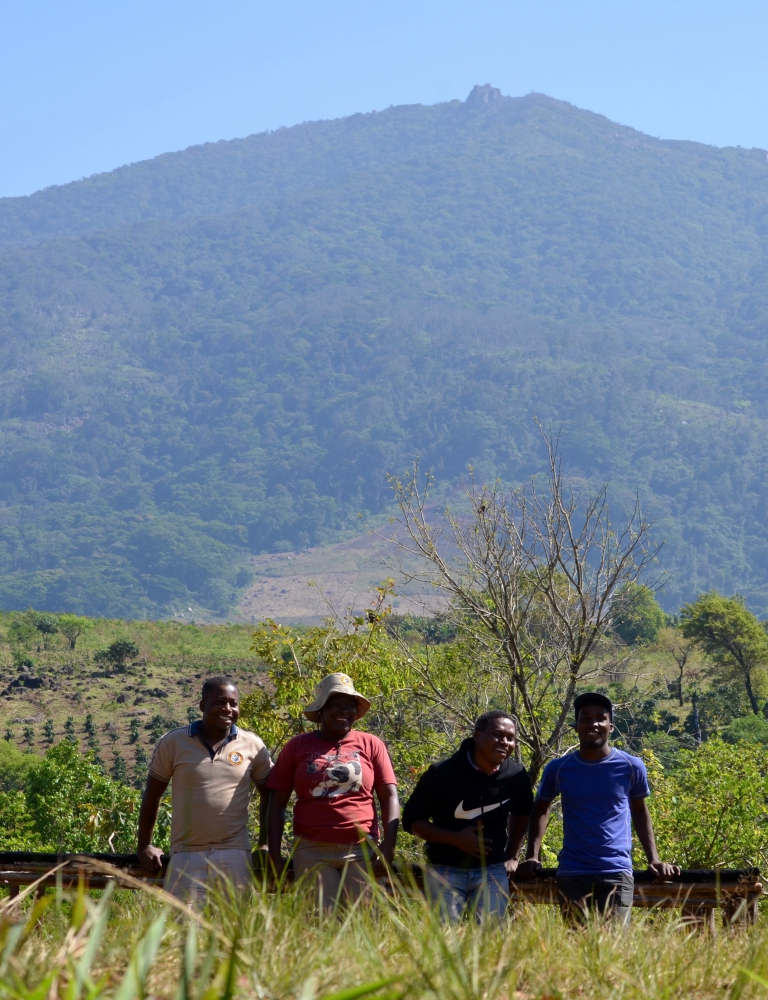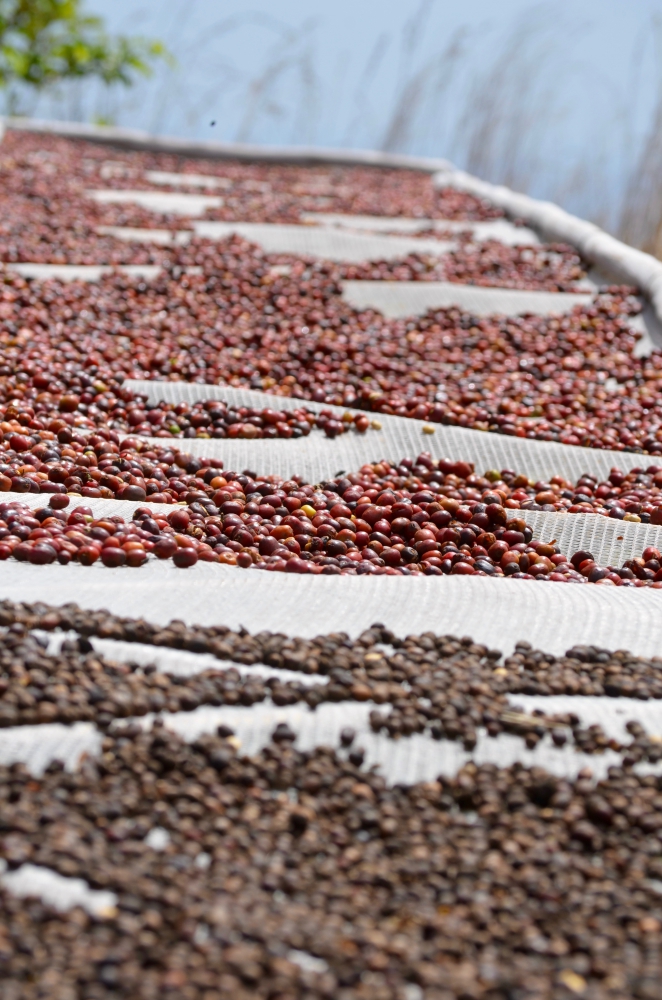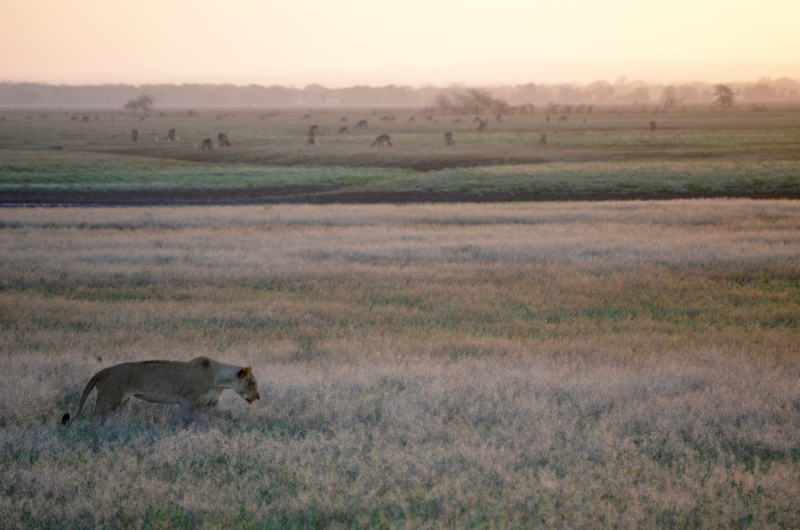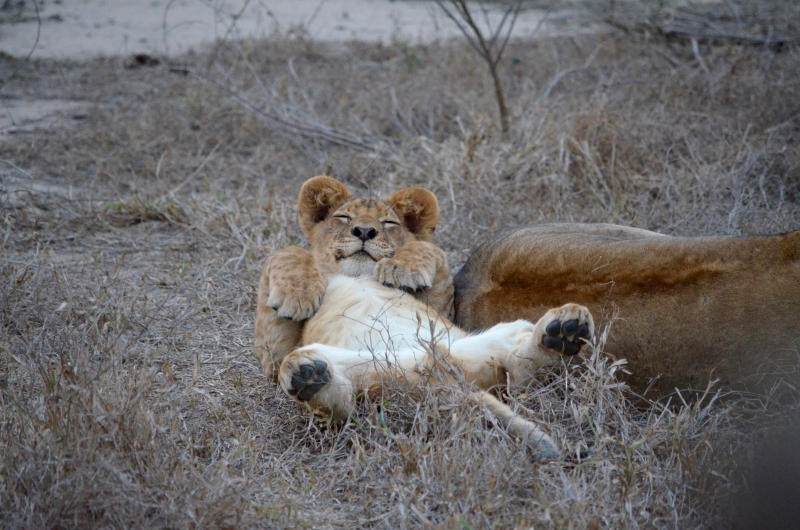Words by Mel Winter and Iain Evans
We lay on our backs on the rolled out camping mattresses, bare feet sticking up in front of us, skin still cool from the mountain waterfall. The wisps of cloud above the top of Gogogo, the highest peak of Mount Gorongosa, turned from orange to pink, painted by the dipping sun. The stars began to appear. Cuth’s knowledge of the constellations and planets came in handy as Venus, Mars and Scorpio revealed themselves to us in the blackening sky. All was calm.
“Gabriel! Gaaaabriel! Gabriiieeel!!”
Through the quiet and stillness of the mountain a voice boomed and we all chuckled. It was Emilia Nacir, our guide and one of the co-ordinators of the Gorongosa Coffee Project, making sure dear Gabriel was on top of the preparation of our extremely fresh chicken for dinner. Emilia defies expectation in a lot of ways. Mozambique is still a patriarchal society and for Emilia to be a community leader and not yet be married is a path not often taken by women here. She is up to the challenge; when Emilia calls, you listen! The wind intensified as we waited huddled around the fire sharing stories, a mix of Portuguese, English and Sena carried around the campsite.
We were gathered in Mozambique in the heart of Gorongosa National Park (GNP) in October 2018 for a very exciting reason. The first ever harvest of coffee from these hills.

The peak of Gogogo, a holy site for the Sena people in Mozambique, one of the last sites of civil war, fought over for its cultural significance, and (as we had learned trekking through the merciless sun) a site of extreme ecological significance. You see, the mountain is the catchment area for four rivers that provide life to millions of people in villages spiralling out from it’s source. Without the indigenous rainforest that acts as a sponge and stabilizes the hydrology of that mountain, it would turn from proverbial mountain to molehill in a sandy, mudslide of erosion. The great mountain captures moisture floating in off the Indian Ocean and from it conjures up the magic and power of four major rivers: Nhandare, Chitunga, Muera and, most importantly, Vunduzi. These rivers provide water to Gorongosa and all communities surrounding the mountain, and without them life in this part of Africa would have never been able to flourish the way it does now. The rivers flow from the mountain in deep, forested ravines. Some form spectacular waterfalls on the slopes of the mountain, the largest being Murombodzi Falls, over 100 m high, and a series of smaller waterfalls are formed by the waters of the Vunduzi River as it flows eastwards towards Lake Urema.
The campsite we stayed in, is where tools for the farmers on the mountain are kept each night. Just across the river lies the coffee nursery. It is an impressive nursery. The project has 40 000 coffee plants in the ground now, with a further 400 000 seedlings in the nursery. Emilia and Sional Moiane, lead supervisor of farmers, brought back several new varietals from Brazil which they are soon going to be planting. Coffee farming provides a way to re-forest the hills destroyed by civil war and slash-and-burn farming techniques used up until this point. Mozambique should be covered in forest. Coffee trees thrive under the shade of forest, so the nursery is also home to a number of fast-growing indigenous, forest trees. The team has big plans.

“To secure a great future for Gorongosa National Park, we must improve the lives of its people. Our goal is healthy families with improved food security, sustainable livelihoods and reduced population pressure around Gorongosa,” says Park Warden, Mateus Mutemba. And coffee farming, along with cashew and honey production, plays an integral role in this mission.
The plan for the Coffee Project is multi-tiered. Plant the coffee trees to provide income for the farmers. Plant rotating crops to feed the community who work the coffee fields.
Plant Indigenous trees to provide shade for the coffee trees and to reinvigorate the forest.
All these steps lead to restoring the biome which means indigenous birds, insects, pollination, animals and a restoration of an eco-system ravaged by decades of civil war and slash and burn farming.
They are implementing an incredible model to uplift locals to become contract farmers. In Year One applicants are given coffee & inter-row crops, like pineapples, beans and the like, to regenerate the nutrients in the soil. In Year Two more new seedlings are giving, farmers are taught crop rotation, mulching, pruning, how to fertilize in places where soil needs re-generation, when to add a bit of lime for acidic base soil. From Year Three the administration team has a track record of which candidates have consistently attended training and they are given more responsibility and eventually become contract farmers.
The success of this project is entirely dependent on working with the local communities and respecting the culture. Matthew Jordan, one of the team leaders in the GCP, recounts an occasion during an attempt to collect climate data. The researchers erected a weather station to collect information. During the time the weather station was there, there was a drought. The community was upset, because they said the ancestors had not granted permission for the station to be erected and that was why there was drought. Whether it was El Niño unpredictability or the ancestors, as soon as the team heeded the warning and dismantled the weather station, the rains came down.
“A real stakeholder in the communities are the Ancestors, “ explains Matt. “It took us some time to convince the local communities to accept the coffee project, but we had to be patient and go through the correct channels instead of forging ahead without their blessing. This has been at the core of our success.”
We met one of the early adopter farmers, Armando Campira. He has 1700 coffee trees in his plot of land. The coffee project has the potential to give him money to build a home and improve his life. The family help to work in the field and are excited about the coffee project. Already this first harvest has provided income and any excess vegetable or fruit crops they produce from the intercrop program are bought by the restaurant at Montebello Resort at Chitengo Camp.
This is a well funded endeavour. After a first visit to GNP in 2008, Greg Carr made it his goal to assist the Mozambican government in restoring the park and managed to secure funding from numerous sources. This has been well documented, but to see first-hand how much has happened in just 10 short years is mind-blowing.
The challenge is to build it to be self-sustaining. With such amazing support, the GNP has been able to secure incredible talent in helping to make the sustainable dream a reality. Quentin Haaroff, a Zimbabwean coffee farmer - is one such talent. He’s the manager of the coffee. We didn’t have the pleasure of meeting him in person, but his legend was on the lips of all who he works with.
“In 2013, I was invited by Greg Carr to help him and his team save the Rainforest of Serra Gorongosa in Mozambique. We have now completed the pilot program which is to develop, with the community who live on the mountain, the production of high quality Arabica rain fed coffee.
We grow shade coffee as one of the ways to preserve the integrity of the Rainforest. We also inspire the local community to reforest selected areas which over time have been transformed by slash and burn. The third intervention is to leave transformed areas alone and let them regenerate naturally, particularly along the river systems that nourish Gorongosa Park with water during the long dry season.
I enjoy the challenge of saving a Park by saving a Rainforest, it is a privilege to work with so many talented people both Mozambicans and from afar who, together, have the passion to make Gorongosa Park a model, to show the rest of the world, how to go about letting People and Wildlife exist together.”
An impromptu game drive yields a lioness sighting, a rare sable antelope, a flock of white headed vulture, scores of waterbuck and through the week we are treated to sightings of Kudu, Maribou stork, bush pigs, African grey hornbill, tiny baby warthogs (cute!) and even some Mozambican nightjar and the endemic Collared Palm thrush. Sadly, we didn’t see two species that are high on the list of avid twitchers and safari goers: The green headed oriole - only found in Mount Gorongoza’s riverine forests - and the pangolin. Both of which, while extremely rare worldwide, are quite prolific within the Park.


“Keep your imagination hat on” says Matt Jordan, “10 years ago there wasn’t a single animal here”.
As a volunteer for the US Peace Corps, Matt landed in Mozambique where he uncovered a passion for conservation.
“My varied career path has left me uniquely qualified for my current position at Gorongosa National Park (GNP). I have a dual appointment at GNP, focusing on programmatic development of science education and in operational management for the production of shade grown coffee on Mount Gorongosa. I am filled with gratitude at having been asked to be a part of the amazing story that is Gorongosa.”
New species are now being discovered constantly. The facilities at Chitengo Camp are world class and groundbreaking research is being conducted to provide a blueprint for future conservation efforts. The Edward O. Wilson Biodiversity Laboratory is a research facility at GNP, an important hub of scientific and educational activity in Mozambique. It has been created to explore, document, and protect biodiversity of Gorongosa National Park as well as to offer research and training opportunities in biodiversity-related fields for students and conservation leaders in Mozambique. The laboratory is named in honor of one of the world's greatest champions of biodiversity conservation, Dr. Edward O. Wilson, who for years has been the leading synergistic force that allowed many scientists and conservationists to come together and focus their energy on the restoration projects in Gorongosa. Currently there are two Mozambican students running their Masters Degree projects from Chitengo Camp.
10 years ago, the Park’s borders no longer existed and the land was home to thousands of desperate and hungry people. There are now 175000 people in 4 districts of buffer zone that live around the GNP. That is a lot of people to care for and provide services to, but one of the core beliefs at GNP is that the health and security of the Gorongosa ecosystem is directly linked to the health and security of the people living around the Park. Therefore, the conservation work isn't just inside the Park, working with majestic animals and beautiful landscapes. Some of the most important conservation work is done outside the Park, in communities and villages in the Buffer Zone, in schools and health clinics. There is basic health education provided as well as training people in the community to become Community Assisters to help while ambulances and medical professionals make the long journey to get to this in need.
“We are trying to be architects of choice. We present the communities with options for solutions and enough information to make educated decisions,” says Matthew. In every part of development Gorongoza National Park is there to teach, not to give handouts, trying to change the mindset and to engage people to be the masters of their own future.
Cuth Bland and Jonathan Robinson of Bean There Coffee Company are part of the network of people that has been employed to assist the Gorongosa Coffee Project in producing the best possible cherries. Jono has been direct trade sourcing coffee for the last 12 years and has visited coffee farms all over the continent, in various stages of development. He is an excellent source of knowledge as a green coffee buyer to assist the team on what buyers are looking for to take back to roasters and which processing methods will attract business. Cuth and Emilia spent a full day roasting coffee on a 2kg Coffee Tech roaster. Cuth enjoyed her time with Emilia thoroughly as uplifting women in coffee is always high on her list of priorities as one of the few female roasters and Q Graders in South Africa.
“There are people in the coffee industry that make others around them better people - not just better coffee people but better people. Emilia is one of these. In a few short years (two) she has learnt to grow, process, taste, roast and distribute coffee, largely self taught through trial and error, mastering the value chain in ways that most of us find impossible. And yet still, she is adamant that she "just wants to get better”. She wasn’t going to let me get away without learning some Portuguese, or with being shy, or trying to hang on to any of the other delicate sensibilities that come along with being politely English. I can fully recommend being called on your s**t by someone who genuinely believes you can do better and will help you if you’re willing to learn. I expected to learn things on this trip, have amazing experiences, taste great coffee - I’m grateful Emilia walked right over those small expectations and made me a better person.”
On our final morning there, the pop-up cafe in the Education Centre’s classroom was in full swing. Gabriel, having acquired impressive barista skills after some top training, hustles alongside Jono to provide cappuccinos to the growing crowd of Chitengo Camp employees. Scientists, farmers, game rangers, researchers, the team from Montebelo Lodge. Cuth and Emilia lead the group in a cupping to taste the different processing methods that have been implemented on this first harvest so that everyone can taste the difference and experience the fruits of the labour of the Coffee Project Team. A community gathered together to taste coffee from the farmers of Mount Gorongosa. A more joyful group of people would be difficult to find. The energy in the room was ecstatic. How did this make Emilia feel?
“I’m so happy! I’ve learnt so much in the past few days about tasting our coffees and roasting them. We don’t produce this coffee just to sell it, we do it to help the community and to give the people of Gorongosa mountain a sustainable way to grow strong.”
In today’s coffee economy a story is essential to engaging green buyers and end consumers and the transformation of this region reads like an adventure novel of epic proportions. Coffee is a long term investment, so the big question at the end of the first major harvest was, does it taste good? What did they taste like?
Hope. Freedom. Prosperity.
But also, mangoes and pineapples and the sweetness of honey.
The coffee tasted like Gorongosa, an embodiment of the bountiful land in which the cherries were grown. We are so excited to taste these coffees as they mature.
